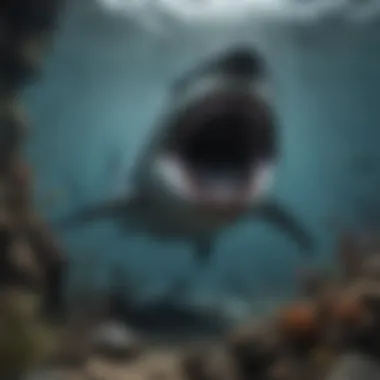Unveiling the Size and Influence of Megalodon Sharks


Intro
The megalodon, a prehistoric giant shark, has long intrigued both scientists and the public. This shark is not simply a larger version of modern sharks. By understanding its size, we uncover significant details about its life, environment, and role in the ancient marine ecosystem. This article presents a detailed investigation into the extensive size of megalodon sharks, emphasizing their physical characteristics, evolutionary implications, and how they engage in the oceanic habitat they dominated.
Intro to Megalodon Shark
The study of megalodon sharks occupies a significant place in marine biology and paleontology. Understanding this ancient predator helps us grasp the dynamics of ocean ecosystems from a time when these sharks roamed the seas. The implications of their size and biological structure provide insights into their hunting strategies and ecological roles. This section will cover key aspects related to megalodon, setting the stage for more detailed exploration later in the article.
Overview of Megalodon
Megalodon, scientifically known as Carcharocles megalodon, lived approximately 23 to 3.6 million years ago. This species is renowned for its massive size, often estimated to have reached lengths of up to 18 meters, or even longer. Its size not only contributed to its predatory prowess but also made it a subject of fascination and study for scientists and the public alike. Fossilized teeth, some measuring over 18 centimeters, provide substantial evidence of its enormous mouth and jaws. These adaptations allowed megalodon to take down large prey, establishing it as an apex predator of its time.
The understanding of megalodon is not limited to its physical attributes. It encompasses aspects like its role in ancient marine ecosystems and how it may have interacted with contemporary species. Its discovery has sparked numerous research efforts that investigate the anatomical and behavioral features that made it a dominant marine hunter.
Importance of Size in Marine Biology
The size of organisms in marine biology is a critical aspect of ecological balance and survival. Megalodon’s sheer scale raises important questions regarding its feeding habits, reproductive strategies, and habitat preferences. Larger size can confer numerous advantages, such as increased predation efficiency and broader ranges for hunting and breeding.
- Predation Efficiency: Larger animals often have a substantial advantage when it comes to predation, as they can tackle bigger prey. For megalodon, this meant that it could consume a variety of large marine animals, such as cetaceans and other sharks, influencing the population dynamics of these species.
- Reproductive Strategies: Size can also affect reproductive strategies. Larger body size may correlate with larger litter sizes or extended periods of gestation, allowing for the successful nurturing of offspring during vulnerable early stages of life.
- Habitat Utilization: Furthermore, megalodon’s size may have dictated its habitat range, pushing it into deeper offshore waters where larger prey could be found and competition with smaller sharks was reduced.
Understanding megalodon's size is fundamental to reconstructing its ecological niche and provides a context for studying marine species evolution.
Ultimately, megalodon serves as an excellent case study for evaluating the significance of size in marine biology. By examining the size of megalodon, researchers can draw parallels to contemporary marine ecosystems, shedding light on how such traits can govern ecological interactions.
Historical Context
Understanding the historical context of the megalodon is crucial for those engaging with the study of marine biology. This background offers insight into not only the existence of the megalodon but also its ecological role during its time on Earth. The megalodon lived during the Cenozoic Era, a period that reflects significant evolutionary changes in marine life. By studying this timeline, we can identify patterns of adaptation and extinction that shape our current understanding of oceanic ecosystems. This section will delve into the geological timeline of megalodon and explore the fossil evidence that has been crucial in reconstructing its history.
Geological Timeline of Megalodon
Megalodon, scientifically known as Carcharocles megalodon, existed approximately 23 to 3.6 million years ago. It dominated the oceans during the late Oligocene to the Miocene epochs. Understanding its timeline helps to contextualize this species within the broader framework of marine evolution. The Cenozoic Era is marked by significant shifts in climate and sea levels, which influenced marine habitats and food sources. The fluctuations of these environmental conditions made it possible for megalodon to thrive.
- Oligocene Epoch (34 - 23 million years ago): Early evidence of the megalodon emerges. The environment favored the proliferation of large marine predators.
- Miocene Epoch (23 - 5.3 million years ago): Megalodon reaches its peak maturity and diversification. This era reflects the climate’s warming phases which expanded marine habitats.
- Pliocene Epoch (5.3 - 2.6 million years ago): The last appearances of megalodon fossils are noted. The environmental changes beginning to occur contribute to the eventual extinction of various marine species.
This geological timeline establishes megalodon as a remarkable creature adapted to a dynamic environment, highlighting how shifts in the Earth influenced its evolution.
Megalodon Fossils and Discoveries
Fossils are the key to our understanding of the megalodon's size, lifestyle, and extinction. These remnants provide tangible evidence of its existence and help reconstruct the biological picture of this awe-inspiring predator. Most notably, megalodon teeth serve as the most abundant fossils discovered, ranging from 3 to 7 inches in length. This size gives crucial insight into the overall dimensions of the megalodon. Unlike bones, teeth are more resilient to decay and conditions that might destroy other parts of the body.
Significant fossil sites around the world have yielded megalodon remains:
- Shark Tooth Hill in California: One of the richest deposits, producing thousands of shark teeth.
- Bone Valley in Florida: A notable site with fossils indicating the ecological presence of large predators.
- South Carolina’s coastal areas: Where unique finds of megalodon teeth have contributed to our understanding of distribution.
"Fossil evidence of the megalodon helps establish its ecological role as an apex predator in ancient marine ecosystems."


Recent discoveries have also sparked debates about the environmental factors leading to the extinction of megalodon. Researchers analyze the existing fossil record to investigate how competition and morphological changes among marine species might have influenced megalodon's decline.
Estimating Megalodon Size
Estimating the size of megalodon sharks is crucial for understanding their ecological role and biology. The sheer scale of these creatures invites questions about their predation techniques, habitat preferences, and interactions with other species. Size estimations help reveal how megalodon sharks fit into their ecosystems. Moreover, it adds to the existing discussions on size-related adaptations in marine biology. Understanding the factors influencing size estimates, such as fossil evidence and anatomical studies, is vital for a holistic comprehension of these ancient predators.
Methods of Size Estimation
Several methods have been developed to estimate the size of megalodons, relying on fossilized remains, notably teeth. The size of a megalodon can be inferred from the dimensions of its teeth, which are robust and distinctive. This approach provides a relatively reliable framework for estimations. Here are some common methods used:
- Tooth Size Analysis: Megalodon teeth are larger than those of any modern shark. By comparing tooth size to the jaw size of extant shark species, researchers derive estimates of overall body length.
- Scaling Methods: Scientists often employ scaling techniques, using the known proportions of modern sharks as a reference. For example, a comparison with the great white shark allows estimates based on proportional size differences.
- Fossil Assemblages: A comprehensive analysis of megalodon fossils against other marine species from the same geological period provides context. Such comparative studies help determine habitat and size adaptations.
- 3D Modeling: Advanced technologies, like 3D imaging, enable researchers to create digital models that simulate the megalodon's body proportions and overall structure. This helps in visualizing the size accurately.
Through these methods, the commonly suggested estimates for the megalodon range from 15 to 25 meters in length. However, ongoing research continues to refine these figures.
Size Comparisons to Modern Sharks
Comparing megalodon size to that of modern shark species provides valuable insights into their evolutionary significance. The most commonly referenced species in such discussions is the great white shark, Carcharodon carcharias.
- The great white shark averages about 4.5 to 6 meters in length. In contrast, the megalodon dwarfs this with its estimated length of up to 25 meters.
- Another relevant comparison is with the whale shark, Rhincodon typus. This species is the largest currently living shark, reaching lengths of about 12 meters, still significantly smaller than megalodon.
- When comparing body mass, it is thought the megalodon could have weighed anywhere from 30 to 70 tons, depending on its size, while a great white typically weighs around 1,000 to 2,500 kilograms.
These comparisons highlight not only the immense size of the megalodon but also its role as an apex predator. Understanding these differences enhances our knowledge of shark evolution and the ecological niches they occupy. As researchers continue to analyze data and make comparisons, our understanding of megalodon size will evolve, reflecting advancements in paleo-biological research.
Physical Characteristics of Megalodon
The physical characteristics of megalodon provide crucial insights into how these enormous sharks operated within their ecosystems. Understanding the unique features of megalodon not only reveals its adaptations but also highlights the evolutionary advantages that contributed to its role as a top predator in the ancient oceans. By studying its body structure, adaptations, teeth, and jaw size, researchers can infer its hunting strategies, prey preferences, and ecological impact. These aspects are essential for grasping how megalodon interacted with its environment and competitors, as well as how it compares to modern marine predators.
Body Structure and Adaptations
The body structure of megalodon is a fascinating topic. Megalodon was not only large, but also robust. The estimated length of this shark is up to 60 feet, and its mass could reach an astonishing 50 tons. Such size required specific adaptations that enhanced its predatory efficiency.
Megalodon possessed a conical body shape, which likely provided excellent hydrodynamics. This streamlined design facilitated swift movements through water, essential for a predator. Its large dorsal fin helped maintain stability during high-speed pursuits. Additionally, megalodon had powerful pectoral fins, broad enough to support maneuverability while hunting.
The megalodon’s skin was covered with dermal denticles, small, tooth-like structures that reduced drag and provided protection from parasites. The unique texture of its skin likely played a role in its ability to glide efficiently through different water layers.
Teeth and Jaw Size
Megalodon's teeth and jaw size are central to understanding its feeding habits. One of the most distinctive features of megalodon was its formidable teeth. These teeth were large, triangular, and serrated, measuring up to 7 inches in length. The size and design of megalodon’s teeth indicate that it was capable of taking down large prey, including whales and other sizeable marine animals.
Moreover, the jaw of megalodon was massive, capable of opening wide to accommodate its large teeth. Research suggests the jaw could exert a bite force of approximately 40,000 pounds, far exceeding that of any known living shark. This enormous bite force allowed megalodon to tear through the flesh of its prey efficiently.
Ecological Implications of Size
Understanding the ecological implications of size in the context of the megalodon is essential as it provides key insights into marine ecosystems during its existence. This section will elaborate on how the size of megalodons influenced their interactions with other marine life, their hunting strategies, and their overall role as apex predators. The enormity of megalodon not only shaped its own behavior but also impacted the evolutionary pathways of various marine species.
Predatory Behavior and Hunting Strategies
The megalodon was an apex predator, capable of preying on large marine animals, including whales and other sharks. Its size affected its predatory techniques significantly. Larger sizes usually correlate with a broader range of prey. Consequently, megalodons likely used bulk and power to their advantage. Their enormous jaws, equipped with rows of serrated teeth, enabled them to easily capture and consume large prey.


Research suggests that megalodon employed ambush tactics, striking swiftly and forcefully. This is particularly notable in how they might have targeted vulnerable marine mammals. Their speed and agility, despite their size, would have allowed them to be effective hunters. Furthermore, studies indicate that their hunting strategies were adapted to maximize success rates in capturing prey, reflecting an evolutionary refinement.
Thus, the ecological role of megalodon as a top predator facilitated a balance in marine food webs, regulating populations of large prey species. This interaction played a substantial part in maintaining the structure and diversity of marine environments in which they thrived.
Habitat and Range
Megalodon's size also influenced its habitat and range. Recognized to inhabit various marine environments, including coastal and open ocean waters, the megalodon preferred areas with abundant food sources. Its significant size allowed it to dominate these spaces, affecting how other marine species interacted with their habitat. Larger predators often require larger territories to sustain their dietary needs, and megalodon was no exception.
The fossil records indicate that megalodon was widely distributed across the globe. This broad range implies adaptability to different marine environments, contributing to its success as a species. However, an extensive habitat range also means that the species had to encounter a variety of other marine organisms, further influencing the ecological dynamics at play in their environments.
Megalodon and the Marine Ecosystem
The study of the megalodon extends far beyond its imposing size. Understanding its role in the marine ecosystem offers insights into the dynamics of ancient seas. As an apex predator, the megalodon held a significant position at the top of the food chain. This article examines the various implications of its existence, focusing on its predatory relationship with other marine life and the impact this had on the broader ecosystem.
Role as Apex Predator
As one of the largest sharks to ever roam the oceans, the megalodon is often regarded as an apex predator. This status implies not only dominance over its prey but also a critical regulatory function within its habitat. The sheer size and strength of the megalodon allowed it to hunt large marine mammals, including whales and other substantial fish species. Its diet likely depended on the availability of prey during the different periods of its existence.
The megalodon's hunting strategy was highly effective. With its formidable jaws equipped with massive teeth, it could inflict significant damage on its prey. The size of the megalodon has allowed scientists to understand how predator-prey dynamics operate in marine ecosystems. Its ability to hunt efficiently ensured that populations of certain species remained in check, preventing overpopulation and maintaining a balance within the marine environment.
Notably, the presence of apex predators like the megalodon can foster biodiversity by allowing a variety of species to thrive. By limiting the abundance of dominant prey species, the megalodon indirectly supports the existence of smaller or less dominant species, creating a more diverse ecosystem.
Impact on Other Marine Life
The historical presence of megalodon had a profound impact on other marine creatures. This apex predator influenced various marine species' evolutionary paths. For instance, some prey species developed adaptations to escape predation, leading to changes in their physical characteristics or behaviors. The dynamic relationship between the megalodon and its prey demonstrates how apex predators can shape the evolutionary landscape of their ecosystems.
Megalodon's extinction marked a significant shift in the marine environment. With its disappearance, the balance maintained by this mighty predator altered, potentially allowing prey populations to increase unchecked. This change could have had cascading effects throughout the marine ecosystem, causing shifts in species distributions and behaviors.
It is also essential to recognize that megalodon was not the only large predator during its time. Other marine reptiles, large bony fish, and modern sharks also occupied the oceans. The interactions between these organisms and the megalodon created a complex web of predatory relationships, defining the structure of the marine community during the Cenozoic era.
"Understanding megalodon’s role in the marine ecosystem helps us appreciate the intricate balance maintained by apex predators in our oceans."
Misconceptions and Cultural Impact
The examination of misconceptions surrounding the megalodon shark is crucial to understanding its cultural significance and the scientific discourse it evokes. Many people recognize the megalodon as a terrifying creature, yet various inaccuracies often distort its image. These misconceptions can stem from media portrayal or popular narratives, leading to an understanding of the megalodon that may not align with scientific data. Addressing these myths helps clarify our perception of this ancient predator and emphasizes its real ecological role.
Megalodon in Popular Culture
Megalodon has significantly impacted popular culture, often depicted in films, literature, and television shows. Movies like "The Meg" exemplify this fascination, portraying the megalodon as a monstrous predator from the depths of the ocean. Such representations can lead to sensationalism, as they often exaggerate the size and behavior of these sharks.
The prevalence of megalodon in social media platforms, such as discussions on Reddit or intriguing posts on Facebook, further perpetuates myths about its aggression and size. While these narratives often capture the public’s imagination, they neglect the scientific realities of megalodon behavior and ecology.
The megalodon's cultural depiction also includes merchandise, toys, and art, influencing younger audiences and their understanding of marine life. This cultural phenomenon can obscure the shark's actual significance in marine ecosystems, leading to a skewed view that emphasizes mythology over biological fact.
Scientific vs. Mythical Representation


The scientific narrative of the megalodon is rooted in fossil evidence and paleontological research, providing insights into its anatomy, behavior, and environmental context. Scientists utilize vital datasets from fossilized teeth and vertebrae to reconstruct the size, diet, and habitat of megalodon. However, these facts often clash with the mythical representations seen in pop culture.
For example, scientists estimate that megalodon could reach lengths between 15 to 18 meters, yet some portrayals suggest it could grow to much larger sizes. This discrepancy can mislead the public about what these sharks were truly like.
In many ways, the scientific approach emphasizes the need for a balanced understanding of megalodon. Scientists stress its role as an apex predator, its hunting strategies, and the species it preyed upon, which is crucial for comprehending oceanic ecosystems of the past.
"Understanding the megalodon requires moving beyond sensational narratives and focusing on scientific evidence to appreciate its ecological importance fully."
Despite the mythos that surrounds the megalodon, it is critical to encourage a dialogue that respects both its cultural impact and the scientific truths that define its existence. This synthesis can enrich both educational initiatives and deepen public interest in marine biology.
Current Research and Future Studies
Current research on megalodon sharks is crucial to expanding our understanding of these ancient giants. Given their unique position in marine evolution, researchers are investigating various aspects including size estimation, ecological impact, and the megalodon's role in past marine ecosystems. Recent studies utilize fossil evidence and technological advancements not previously available. This ongoing research informs both paleontology and modern marine biology, providing insights into how large predators have evolved over millions of years.
Advancements in Technology for Megalodon Research
Technology plays a pivotal role in megalodon research today. Techniques such as 3D modeling and CT scans of fossils allow scientists to visualize structures that were once difficult to analyze. These methods enhance our understanding of megalodon anatomy and physiology. Genetic analysis of shark samples also helps in understanding the evolutionary links between megalodon and modern shark species.
- 3D Imaging: This technique offers precise depictions of fossil remains, revealing details about body shape and size.
- CT Scans: These scans enable non-invasive examinations of hard tissues, giving insights into jaw structure.
- Genomic Studies: Analysis of DNA from contemporary relatives sheds light on the genetic evolution of megalodon traits.
"Innovative technologies reshape our comprehension of ancient marine life and contribute significantly to evolutionary biology."
Future Implications for Marine Biology
The future of marine biology will likely benefit from the insights gathered through megalodon research. By understanding how megalodon adapted to its environment, scientists can make educated predictions about resilience and adaptability in marine species today. For example, analyzing megalodon's predatory behavior might reveal strategies that other large marine predators can utilize for survival in shifting oceanic conditions due to climate change.
Additional benefits to marine biology may include:
- Enhanced knowledge on species interactions within ecosystems.
- Mapping the evolutionary trajectory of marine predators.
- Informing conservation efforts for endangered shark species by drawing parallels with historical predators.
In summary, examining the size and ecological significance of the megalodon is not merely about understanding a bygone creature. The ongoing research helps illuminate the complex dynamics of marine ecosystems and the evolutionary pressures acting on them.
Ending
The conclusion of this article plays a crucial role in synthesizing the vast information about megalodon sharks. It not only reinforces key findings but also highlights the significance of understanding this ancient predator in relation to marine evolution. The sheer scale of megalodon and its adaptations to the marine environment provide insight into the dynamics of ancient ecosystems. Assessing megalodon’s size reveals the evolutionary pressures that shaped predatory behaviors not just among sharks, but across marine life.
Summarizing Key Findings
To summarize, several critical observations emerge when evaluating the megalodon. First, megalodon was vastly larger than modern sharks, with estimates suggesting lengths of up to 60 feet or more. This size rendered it an apex predator, essential for maintaining the balance within marine ecosystems. Fossil evidence points toward specialized hunting strategies, including targeting large marine mammals.
Key points include:
- Size Estimate Methods: Various techniques such as tooth size and comparisons with contemporary species provide insights into megalodon’s dimensions.
- Ecological Role: Its position as an apex predator dramatically influenced the evolution and behavior of other marine life.
- Public Perception: Misconceptions about megalodon's size and behavior in popular culture affect how people view its ecological significance.
Through this comprehensive analysis, it becomes evident that megalodon was not just a giant shark but a pivotal part of its ecosystem.
Megalodon’s Legacy in Marine Evolution
Megalodon’s legacy in marine evolution extends beyond its impressive size. It stands as a testament to the evolutionary process, demonstrating how size can confer advantages in predation. This brings attention to the evolutionary concept of adaptive radiations, where species evolve diverse traits to fill specific ecological niches. The megalodon, as a forerunner in marine predation, likely influenced the development of various shark species we see today.
The extinction of megalodon, believed to be around 3.6 million years ago, marks a significant shift in aquatic life. As this apex predator disappeared, new predators emerged, leading to changes in marine dynamics that influenced modern-day shark species. The size and ecological presence of megalodon shaped survival strategies and predatory behaviors within larger marine habitats.
Underlining the megalodon’s remarkable adaptability and significant role in marine ecology provides a deeper understanding of contemporary species’ evolution.







